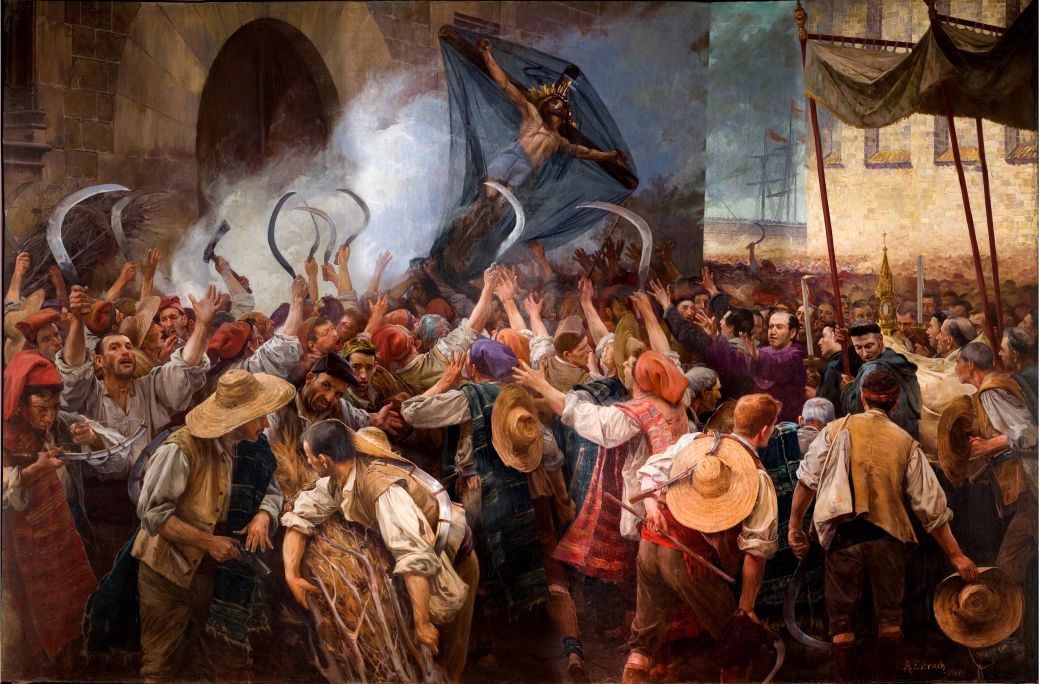Research traces how Spain's rioting rebel 'Segadors' now viewed as national heroes
LAWRENCE — The peasant rebels known as segadors (“reapers”) rioted in Barcelona in 1640, triggering a war that led to the 12-year secession of the Spanish territory.
But who these segadors actually were and how their legacy has evolved is the subject of a new article titled “The Segadors of La Renaixença: Literature Shaping History.” The article traces how the image of these insurgents changed from undesirable rioters to national folk heroes. It’s published in Catalan Review.
 “Since they’re seen as heroes, people think they were always heroes, whereas for most of their history they were seen as criminals,” said Luis Corteguera, professor and chair of the Department of History at the University of Kansas.
“Since they’re seen as heroes, people think they were always heroes, whereas for most of their history they were seen as criminals,” said Luis Corteguera, professor and chair of the Department of History at the University of Kansas.
This radical group is best known today because of “Els Segadors,” the national anthem of Catalonia, an autonomous community of Spain in which the regional capital Barcelona is located.
“Strike with thy sickle / Defenders of the land” goes the chorus of the song, popularized in the 1890s.
Yet the tune’s defiant nature eventually was deemed “threatening” to the republic, and it became illegal to perform in Spain during Francisco Franco’s nearly 40-year dictatorship.
 “The anthem was a source of debate since some people still thought that these rebels — although they’re made grandiose in the song — were not necessarily the kind of heroes you should have,” Corteguera said. “But then it changed because anything Franco didn’t like, Catalans now were going to defend.”
“The anthem was a source of debate since some people still thought that these rebels — although they’re made grandiose in the song — were not necessarily the kind of heroes you should have,” Corteguera said. “But then it changed because anything Franco didn’t like, Catalans now were going to defend.”
In 1993, “Els Segadors” was signed into law as the official Catalan national anthem. Today, it’s familiar to all FC Barcelona soccer fans, who sing it at the start of games as an expression of nationalist pride.
Corteguera’s task became more complicated when investigating how the segadors themselves have influenced the country’s culture.
“The facts about the segadors are very few," he said. "They’re kind of an anonymous group. There was a riot and there were a lot of witnesses, but we don’t know much beyond that. But it’s the history of the myth that remains the challenge. When do stories start about where these people came from?”
He found that it was likely in the 19th century when romantic authors began bolstering the image of these rebels.
“They imagined symbols like the scythe, which is a typical symbol of these kinds of workers,” he said. “But that’s probably a romantic invention. Taking this knot of ideas that is really compact and then unwinding it has been very difficult.”
Corteguera spent the summer in Barcelona, further researching the topic. This included visits to the Museum of the History of Catalonia in which he was “surprised and perplexed” by the lack of concrete information on display about the segadors.
“I’ve always been interested in things some would say are irrational: myth, feelings, sentiments,” he said. “Why do people rebel? Why do people risk their lives? Why are people violent? That is what I was looking at in the actual historical figures.
"But I’m also interested in how people are moved by myths and anthems. And with the rise of nationalism, in how those ideas shape people.”
The topic became relevant once again when the regional parliament of Catalonia declared independence in 2017, its members standing up to sing “Els Segadors” after casting their vote. The Spanish government considered the vote illegal, and a few weeks afterward, Spain suspended the government of Catalonia and ordered the arrest and removal of the main figures involved. Many were imprisoned, and several (including ex-president Carles Puigdemont) went into exile.
The story has relevance beyond Europe. Corteguera cites the Jan. 6 insurrection at the U.S. Capitol, for instance.
“It makes us wonder historically: When do we decide these people are a danger, and when are they heroes?” he said.
“For a lot of individuals, the events of Jan. 6 were almost heroic, and many of those people used the flags of the patriots from 1776. There was talk of ‘saving the nation.’ Looking back to what happened in 1640, those events led to a war that lasted 12 years. One can look at it and say, ‘Well, that was a very brave action.’ But for other people, the start of a war is a disaster.”
Now in his 28th year at KU, Corteguera studies early modern European history, specializing in Spain, the Spanish Empire and Catalonia. He is a native of San Juan, Puerto Rico.
Does he now consider the segadors heroes?
“Heroes come from myths — it’s a value that one adds to them,” he said. "Clearly, they were brave. It’s amazing how unorganized individuals who were mostly unarmed were able to get together and fight the royal armies.
"On the other hand, there’s still the sense that they were basically rebelling out of anger. It was unclear what they wanted to achieve. When one thinks of heroes, one should think of what they stand for.”
Top photo: "Els segadors (The Reapers)," Antoni Estruch, 1907.